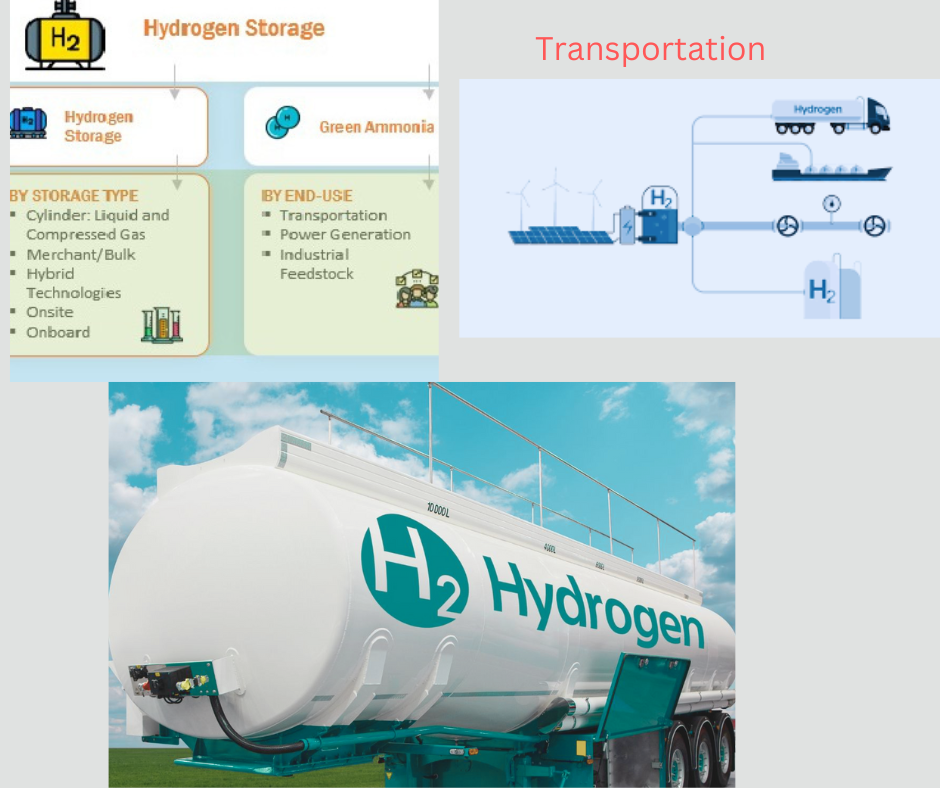Current and evolving hydrogen storage and transportation technologies aim to address the challenges of storing and transporting hydrogen efficiently and safely.
1. Compressed Gas Storage:
Compressed gas storage is a well-established and widely employed method for storing hydrogen, particularly in small-scale applications, hydrogen refueling stations, and various industrial processes. This method involves compressing hydrogen gas and storing it in high-pressure tanks or cylinders, typically at pressures ranging from 350 to 700 bar.
Compressed gas storage is a well-established and reliable method for storing hydrogen, particularly in small-scale applications and industries. As the demand for hydrogen as a clean energy carrier continues to grow, innovations in storage technologies and infrastructure development are expected to further enhance the viability and sustainability of hydrogen as an energy source.
2. Liquid Hydrogen Storage:
Hydrogen can be liquefied by cooling it to extremely low temperatures (-253°C or 20 K). Liquid hydrogen offers higher energy density compared to compressed gas storage, enabling more hydrogen to be stored in a given volume. It is commonly used in aerospace applications and for large-scale storage at hydrogen production and distribution facilities.
Liquid hydrogen storage is a well-established method that offers higher energy density and is commonly used in aerospace applications and large-scale hydrogen storage facilities. While it presents certain challenges, ongoing advancements in cryogenic technologies and materials are expected to enhance the viability and efficiency of liquid hydrogen storage in the future.
DOWNLOAD- https://www.marketsandmarkets.com/industry-practice/RequestForm.asp
3. Metal Hydride Storage:
Metal hydrides can absorb and store hydrogen, releasing it when heated. This technology offers the advantage of reversible and safe hydrogen storage. However, metal hydrides typically have lower hydrogen storage capacity compared to compressed gas or liquid hydrogen storage, limiting their use to specific applications.
Metal hydride storage offers a safe and reversible method for storing hydrogen, making it suitable for specific applications where safety and controllability are crucial. However, its lower hydrogen storage capacity limits its use to scenarios where space and weight constraints are not as critical. Ongoing research and development efforts seek to address these limitations and enhance the viability of metal hydride storage for a broader range of hydrogen applications.
4. Chemical Hydride Storage:
Chemical hydrides, such as ammonia (NH3) or organic hydrides, can store hydrogen through chemical reactions. They have the potential to provide high-density hydrogen storage and enable easier transportation and handling. Chemical hydrides can be converted back to hydrogen when required using a catalyst or thermal energy.
Chemical hydride storage is a promising method for high-density hydrogen storage with advantages in safety and convenience. While it has challenges related to efficiency and material selection, ongoing research aims to address these issues and expand the use of chemical hydrides in various hydrogen storage and transportation applications.
5. Hydrogen Carriers:
Hydrogen carriers involve chemical compounds that can release hydrogen upon demand. One example is liquid organic hydrogen carriers (LOHC), which store hydrogen in a liquid form using a reversible hydrogenation and dehydrogenation process. Hydrogen carriers offer the advantage of easier and safer transportation and can utilize existing infrastructure like pipelines and tanker ships. hydrogen carriers, including LOHC, offer a promising approach to store and transport hydrogen in a safe, convenient, and energy-efficient manner. They have the potential to play a significant role in the transition to hydrogen-based energy systems and can leverage existing infrastructure for greater adoption.
Regarding cost efficiency, it depends on various factors such as the scale of the storage or transportation system, technology maturity, and specific application requirements. Currently, compressed gas storage is relatively cost-efficient for smaller-scale applications, while larger-scale storage facilities often use liquid hydrogen storage due to its higher energy density.
To integrate these technologies into the current hydrogen supply chain, several considerations should be addressed:
1. Infrastructure Development:
Storage and transportation infrastructure, such as pipelines, storage tanks, and refueling stations, must be established or retrofitted to accommodate the specific storage and transportation methods chosen. establishing or retrofitting hydrogen storage and transportation infrastructure is a complex but necessary process to support the use of hydrogen as a clean energy carrier.
The development of this infrastructure is closely tied to the choice of hydrogen storage and transportation methods, and it plays a crucial role in enabling the practical integration of hydrogen into various energy systems and industries.
2. Safety and Regulatory Compliance:
Stringent safety measures and regulations should be in place to ensure the safe handling, storage, and transportation of hydrogen in different forms.
Safety and regulatory compliance are paramount when it comes to the handling, storage, and transportation of hydrogen in its various forms.
Hydrogen is a highly flammable and potentially explosive gas, and its safe use is essential to protect both people and the environment. To ensure safety and compliance, stringent measures and regulations are put in place.
3. System Integration:
System integration in the context of hydrogen storage and transportation refers to the process of seamlessly incorporating hydrogen technologies into the existing supply chain and infrastructure. This integration is essential to ensure the efficient and effective adoption of hydrogen as an energy carrier.
4. Logistics and Distribution Planning:
Logistics and distribution planning is a critical aspect of the hydrogen supply chain, ensuring that hydrogen is efficiently transported from production facilities to end-use applications. Effective planning in this regard considers various factors to optimize the transportation process, including distance, demand, storage requirements, safety, and economic efficiency.
READ MORE- https://www.marketsandmarkets.com/industry-practice/hydrogen/storage-transportation-technologies


